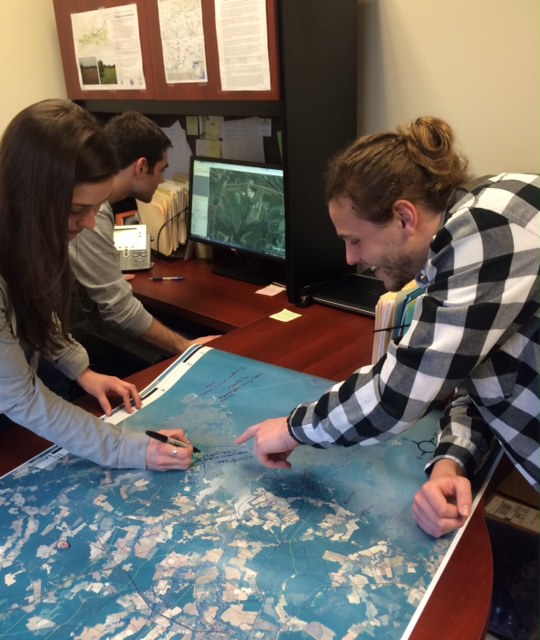Posted: February 10, 2017
Agriculture and Environment Center interns work with public and private sector partners to create a blueprint for restoring an impaired watershed.
Prior to this past summer, Rob Ost, from Potomac, Maryland, had never been to the bucolic Chiques Creek watershed in Lancaster County. Now he sees it in his sleep.
Rob, a Penn State junior majoring in Environmental Resource Management (ERM) interned at the AEC last summer and fall. On day one, he dove right into a major project: working with diverse public and private sector partners to develop a comprehensive watershed assessment and restoration plan for the Chiques, a high priority watershed for the Commonwealth.
Funded by the National Fish and Wildlife Foundation, the AEC is facilitating "Chiques Creek Reenvisioned," a large and diverse partnership in the Chiques watershed. This includes the Chiques Creek Watershed Alliance, municipalities, the Lancaster County Conservation District, Lancaster County Conservancy, PA Department of Environmental Protection, Susquehanna River Basin Commission, LandStudies, Inc., Stroud Water Research Center, Chesapeake Bay Foundation, Alliance for the Chesapeake Bay, Lancaster County Planning Commission, TeamAg, Inc., and more.
Rob began with a set of projects already identified through a watershed action planning process conducted by partner LandStudies, an ecological consulting firm from nearby Lititz. After mapping these projects, he conducted a desktop analysis of aerial imagery in the watershed to identify additional potential restoration projects, like riparian buffers, stream restoration, and stormwater basin retrofits, and mapped them using GIS. Armed with his maps and data sheets, Rob and fellow summer intern Tyler Erb, a May 2016 ERM graduate, accompanied the AEC team of Kristen Kyler, Hillary Lyle, Jennifer Fetter and Matt Royer to conduct a windshield survey of the watershed.
"This allowed us to ground truth the potential projects identified in the aerial imagery, and add additional sites we identified from driving the watershed," explained Rob. "We drove many roads, and crossed the Chiques and its tributaries countless times. It certainly is an effective way to get to know a watershed!"
The team spent three full days driving the 125-square mile watershed, which is around 80% agricultural but also has mixed urban and suburban land uses. The boroughs of Manheim and Mt. Joy are located in the watershed, as is a commercially developed section of Route 283 west of the City of Lancaster.
All told, the assessment identified several hundred project opportunities, the majority of them forest riparian buffers. Projects were identified in field data sheets and marked on maps. Then it was back to the computer for Rob.
"Following the windshield survey, there were a lot of adjustments to the data layer," noted Rob. "We learned the importance of conducting a field assessment. You get to see up close what project opportunities exist and where, can eliminate ones which have already be implemented, and add projects which you just can't identify well from looking at aerial imagery. It's a critical part of the watershed planning process."


